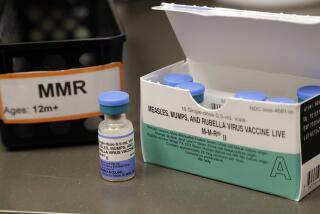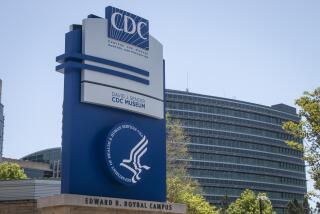Two Cases Elevate Fear on Anthrax
- Share via
NEW YORK — Anthrax infections in two East Coast women with no known links to contaminated letters are forcing government officials to rethink basic assumptions about how easily the disease may infect people and how widely it may have spread through the mail.
Government investigators said Tuesday they could not explain how the deadly bacteria infected a New Jersey bookkeeper, who is recovering from skin anthrax, and a 61-year-old New York hospital supply clerk who is critically ill with the more dangerous inhaled form of the disease.
The women are the nation’s 15th and 16th confirmed anthrax victims, but neither appears to have received suspicious mail or spent time at a contaminated postal facility.
“Did they get infected from a piece of mail that went to their home?” asked Dr. Anthony Fauci, director at the National Institute of Allergy and Infectious Diseases. “That is being intensively investigated right now.”
Rep. Rush D. Holt (D-N.J.), whose Capitol Hill office tested positive for anthrax traces, said the newest cases raise the level of concern for everyone.
“Up until now, it was easy for most people to say: ‘Well, I don’t work in a post office and I’m not a public figure, so therefore I don’t have to worry,’ ” Holt said.
The greatest concern involves the New York woman, who asked officials not to disclose her name.
Because of her infection, health officials advised anyone who had spent at least one hour since Oct. 11 in the Manhattan hospital where she worked--an estimated 5,500 employees, patients and visitors--to start taking antibiotics.
Until now, health officials have assumed that an inhalation anthrax infection could only be acquired by a person who breathed thousands of anthrax spores.
That, they believed, would be impossible unless a person came into direct contact with a letter containing anthrax. So-called cross-contamination--a letter simply picking up spores by moving through the postal system--would not be enough, officials have thought.
If the woman received such a letter, that would be a significant new front in the anthrax problem. To date, the only confirmed anthrax-laced letters have been to media organizations and the office of Senate Majority Leader Tom Daschle (D-S.D.).
If she did not receive a letter, however, then officials must confront the possibility that anthrax is more infectious than they had believed.
“It’s not what we know or don’t know that gets us in trouble; it’s what we know that turns out to be wrong,” said John D. Clements, chairman of microbiology and immunology at the Tulane University School of Medicine. “This could be a classic example of that.”
Government officials have relied on research conducted by the Department of Defense in the 1980s which suggested that inhaling 8,000 anthrax spores can cause lethal infections in monkeys. Other studies by the World Health Organization place the figure at 50,000 spores among animal hide workers in Third World countries. A 1999 paper in the Journal of the American Medical Assn. suggests that inhaling 2,500 spores or more will cause an inhalation infection.
Dr. Bradley Perkins, an anthrax expert at the Centers for Disease Control and Prevention in Atlanta, said Tuesday that no one can accurately pinpoint the number of spores needed to cause infection in humans.
“We know at the two extremes,” he said, noting that a large number--above 5,000, for example--clearly poses a significant human danger. Fewer than 10 pose very little risk.
“It’s what’s in between” that is at issue, he said. “We don’t have either research experience or even clinical experience or epidemiological experience to be able to give a definitive answer on that.”
Some researchers say the spore mystery is like so many other public health issues surrounding anthrax: a case where the demands of the investigation are running up against the limits of scientific knowledge of the subject.
It could be, Clements said, that there is no simple number of how many spores are necessary to infect a person. Perhaps, he said, each person’s risk of infection depends upon his or her own immune system and lung capacity.
Because of the invisibility of the spores and the uncertainty about numbers needed for infection, some experts say officials should err on the side of caution.
“Any place that has one spore should be shut down and decontaminated,” said Philip Hanna, a microbiologist at the University of Michigan. “Nobody in and out, no press conferences held in that building. They should test it many times before they let people back in.”
The New York victim began to feel achy and feverish Thursday, New York Health Commissioner Dr. Neal Cohen said. Though feeling ill, she went to her job in the stockroom of the Manhattan Eye, Ear and Throat Hospital.
By Sunday afternoon, she was unable to breathe and went to the Lenox Hill Hospital with symptoms of pneumonia, Cohen said. In the waiting room, she became lightheaded and fainted. She was admitted to the hospital and was immediately tested for anthrax exposure.
“As far as we know, she is otherwise a healthy woman,” said Michael Tapper, chief epidemiologist at Lenox Hill. “The only medication she took was for high blood pressure.”
Doctors at Lenox Hill notified the local health department late Sunday evening. After initial tests Monday indicated that the woman had been infected with anthrax, state health department physicians interviewed all staff members at her workplace about their own health. So far, 25 employees have been tested for anthrax exposure. The results are pending.
The case has set off a massive effort to track down the woman’s friends and trace her activities and travel. Twenty-seven environmental samples have been taken from the woman’s apartment in the Bronx.
So far, no samples taken at her workplace, which was closed until further notice, have been positive.
Tommy G. Thompson, secretary of Health and Human Services, raised the possibility Tuesday that the woman might have been infected from a tainted piece of mail sent to the hospital. He noted that she occasionally worked in the hospital’s mail room and that earlier this month the mail room and stockroom were combined.
Employees milled in front of the Manhattan Eye, Ear and Throat Hospital on Tuesday, talking nervously about how their normally calm office was in chaos. Many were confused about how to protect themselves.
“We were told not to go to our primary physicians. But no one will tell us what’s really going on,” said hospital employee Michele Briggs. “All they’ve done is herded us one place to another. It’s absolutely horrible.”
Meanwhile, the U.S. Postal Service officials announced ambitious plans to begin sanitizing billions of pieces of mail. The sterilization plan would begin with all mail addressed to government officials and would eventually include 50 billion pieces of mail dropped off each year in public places, such as collection boxes on the street.
“The mail is safe,” Postmaster General John Potter said Tuesday, though he also repeated his warning that people should wash their hands after handling letters.
Investigators are looking into the possibility that the New Jersey woman received mail at home or at work that was contaminated with anthrax spores when it passed through the Hamilton Square, N.J., postal facility. Three known anthrax-laced letters--to Daschle, NBC News anchor Tom Brokaw and the New York Post--were processed there.
Despite the lack of scientific certainty, some government leaders said ordinary citizens have little reason to be concerned about opening their mail.
“When you’ve got 25 billion pieces of mail out there [since the first anthrax outbreak] and one possible contamination . . . we still think you ought to open your mail and you ought to use the postal system,” homeland security chief Thomas J. Ridge said.
The New York case makes that city the latest focus of the anthrax scare. CDC epidemiologists and additional testing resources have been dispatched to New York to assist in the investigation.
In the Washington area, there were no new reports of confirmed or suspected infections, though traces of the bacteria were found at two new neighborhood postal facilities: at the Friendship Heights post office in the District of Columbia and at a facility in Dulles, Va.
The amounts of anthrax detected were small, and cleanup was expected to be completed this week, according to John Nolan, the deputy postmaster general.
Near the Capitol, several congressional office buildings remained closed, including the Hart Senate Office Building, where the Daschle letter was opened Oct. 15.
That letter, the only one so far that has surfaced in Washington, held about 2 grams of anthrax, containing “billions of spores,” said Rep. Mike Pence (R-Ind.).
Senate leaders plan to have the Hart building fumigated with chlorine dioxide gas and reopened by mid-November. Other Washington offices have been treated with an anthrax-killing foam.
Trace amounts of anthrax also were found in the mail room of the U.S. Department of Agriculture. That brings the total number of contaminated sites in the Washington area to more than 20.
Investigators suspect that at least some of that contamination was caused by additional letters that have not been discovered. More than 30 tons of government mail have been shipped to Ohio to be treated by a private company to kill any potential contamination.
To reduce the future threat of bioterrorist attacks via the mail, postal officials said Tuesday they want to make the extraordinary cleanup effort a standard procedure for handling government mail. In the future, all mail addressed to government offices--from constituent letters to elected officials to government invoices--will be irradiated with the same technology used to sanitize fruits and vegetables, Potter said.
The Postal Service plans to install such equipment in Washington so that future government mail will not have to be sent to Ohio. Postal carriers will also be trained to inspect incoming government mail and identify suspicious letters.
The cost of the new machinery, cleanup and medical treatment for thousands of workers exposed to anthrax is expected to be several billion dollars, Potter said at a congressional hearing Tuesday.
*
Huffstutter reported from New York, Ornstein and Rosenblatt from Washington. Times staff writers Megan Garvey, Rosie Mestel, Edmund Sanders and Marissa Schultz contributed to this report.
More to Read
Sign up for Essential California
The most important California stories and recommendations in your inbox every morning.
You may occasionally receive promotional content from the Los Angeles Times.










